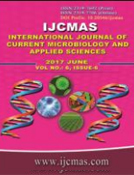


 National Academy of Agricultural Sciences (NAAS)
National Academy of Agricultural Sciences (NAAS)

|
PRINT ISSN : 2319-7692
Online ISSN : 2319-7706 Issues : 12 per year Publisher : Excellent Publishers Email : editorijcmas@gmail.com / submit@ijcmas.com Editor-in-chief: Dr.M.Prakash Index Copernicus ICV 2018: 95.39 NAAS RATING 2020: 5.38 |
Nitrogen use efficiency (NUE) in the rice field is approximately 33%, poorest among cereals and a substantial proportion of the remaining 67% is lost into the environment, reducing economic efficiency of applied N. This calls for immediate development of comprehensive approach to optimize N management. Moreover, plant-useable N is consumed as nitrate (NO3-) from aerobic soils and as ammonium (NH4+) from flooded wetland, anaerobic soils. Therefore, the form and amount of N available to the rice can be improved by harnessing the innate efficiency of genotypes to utilize the available N, grow well and yield better. Considering, the above fact the present study was under taken for evaluation of 32 lines of F14 generation of recombinant inbred lines from the cross of Danteswari/Dagaddeshi rice genotypes for yield and nitrogen related traits. Under NH4+ treatment, grain yield was highest with mean phenotypic value of 241.1 g/m2 followed by NO3- treatment with exhibiting average value of 179.1 g/m2 and lowest average phenotypic value of 57.2 g/m2 under N0 treatment. Differences were significant between nitrogen levels for yield and NUE component traits. Genotype×nitrogen interaction effect was significant for most of the traits. Nitrogen and NUE traits had genotypic coefficient of variation less than phenotypic coefficient of variation under all sets of treatment indicating significant role of environment in the expression of these traits. Broad sense heritability estimates for evaluated traits ranged from 8.2% to 84.1%. The average phenotypic value of nitrogen uptake efficiency, nitrogen utilization efficiency and nitrogen use efficiency under NH4+ treatment was 0.22 gg-1 N, 21.8 gg-1 N and 5.02 gg-1 N while under NO3- treatment 0.17 gg-1 N, 25.1 gg-1 N and 4.7 gg-1 N. On contrary under, N0 treatment mean values were 0.10 gg-1, 30.5 gg-1 and 3.3 gg-1. The results suggested that genotypes G-31 and G-1 were relatively nitrogen efficient variety or genotype.
 |
 |
 |
 |
 |